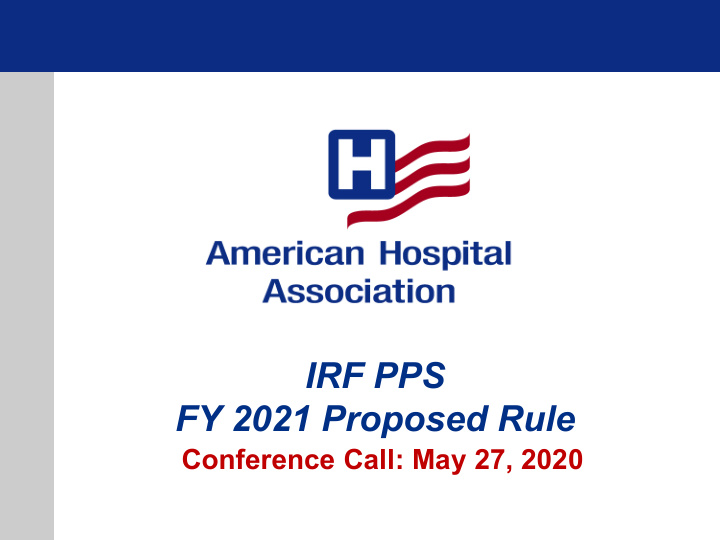



IRF PPS FY 2021 Proposed Rule Conference Call: May 27, 2020
FY 2021 P Proposed R Rule – PAY AYMENT FY 2021 – Comments due by June 15 – Very brief rule – No PPS structural changes Proposed Payment Update • 2.5% net payment increase – $270 million increase over FY 2020 payments 2.9% market basket update o -0.4% for productivity o
Proposed W Wage I Index C Change • OMB announced new wage area boundaries in Sept. 2018; • Further boundary updates issued in Mar 2020; if needed, adjustments would be proposed for FY 2022; • Proposed FY 2021 changes • Budget neutral overall • 5% cap on any decrease (no cap in FY 2022) • 34 urban counties change to rural • 47 rural counties change to urban 3
Proposed R Remo moval of of Pos ost-adm dmission n Physician E n Evalua uation R n Requi uirement • CMS Rationale: • IRFs are more knowledgeable, relative to when this requirement was initially implemented, in determining whether a patient meets IRF coverage criteria prior to admission. • In FY 2019, only on four occasions did the post-admission evaluation alter the determination that an IRF admission was warranted. • CMS: IRFs are conducting appropriate due diligence while completing the required pre- admission screening. • MedPAC • Beneficiaries whose conditions do not require close physician oversight can be appropriately cared for in other, less-intensive settings at a lower cost to Medicare. • Relaxing conditions of coverage and payment that have been established, in part, to ensure that Medicare’s higher payments are warranted, calls into question whether such payments may be too high. • It also underscores the need to move away from payments based on setting and toward a unified PAC payment system • NOTE: CMS’s March 31 interim final rule implemented a temporary waiver of this particular patient evaluation for the duration of the COVID-19 emergency period. 4
CMS’s A Actions o on N New I IRF F Flexibilities FY 2018 Proposed Rule: • Request for information (RFI) from stakeholders re ways to reduce the burden for IRFs and physicians, improve quality of care, and decrease costs. FY 2019 Proposed Rule: • CMS solicited comments on potentially allowing non-physician practitioners to fulfill some of the requirements that rehabilitation physicians are currently required to complete. FY 2019 IRF Final Rule: • CMS allowed the post-admission evaluation to count as one of the three face-to-face visits required weekly by a rehabilitation physician. • CMS allowed rehabilitation physicians to lead weekly interdisciplinary meetings remotely (by video or telephone conferencing) without additional documentation requirements. FY 2020 Final Rule: • CMS clarified that each IRF may define whether a physician qualifies as a rehabilitation physician. FY 2021 Proposed Rule: • CMS states that non-physician practitioners have the training and experience to perform certain IRF requirements and that utilizing non-physician practitioners would increase access to post-acute care services in areas with physician shortages. • CMS proposes to remove the post-admission physician evaluation and to allow non-physician practitioners to perform services and documentation currently required by a rehabilitation physician. 5
Cu Curre rrent R Rehabilitation Physicia ian R Requir irements IRF patients must need physician supervision, including: • at least 3 face-to-face visits per week throughout the patient's stay in the IRF to assess the patient both medically and functionally; • a comprehensive preadmission screening within the 48 hours immediately preceding the IRF admission; • a post-admission physician evaluation conducted within 24 hours of admission (which, as noted above, can be counted as one of the required physician face- to-face visits during the first week of care);3 • an individualized overall plan of care for the patient that is developed by a rehabilitation physician with input from the interdisciplinary team within 4 days of the patient's admission to the IRF; and • an interdisciplinary team approach, including weekly team meetings led by a rehabilitation physician. 6
Pol olicy Q Question ons • Given the trend of recent IRF flexibilities, how far is too far? • AHA members: • Don’t dilute the IRF role. • Don’t make changes that could be interpreted as equating IRFs and SNF. • COVID has highlighted the sizeable gap between SNFs/nursing clinical capacity and that of PAC hospitals. • AHA comment letter : seeking input on physician evaluation and other issues of concern. 7
CONTA TACT: Rochelle Archuleta, Director of Policy rarchuleta@aha.org MATERI RIAL ALS: www.aha.org/postacute
Recommend
More recommend